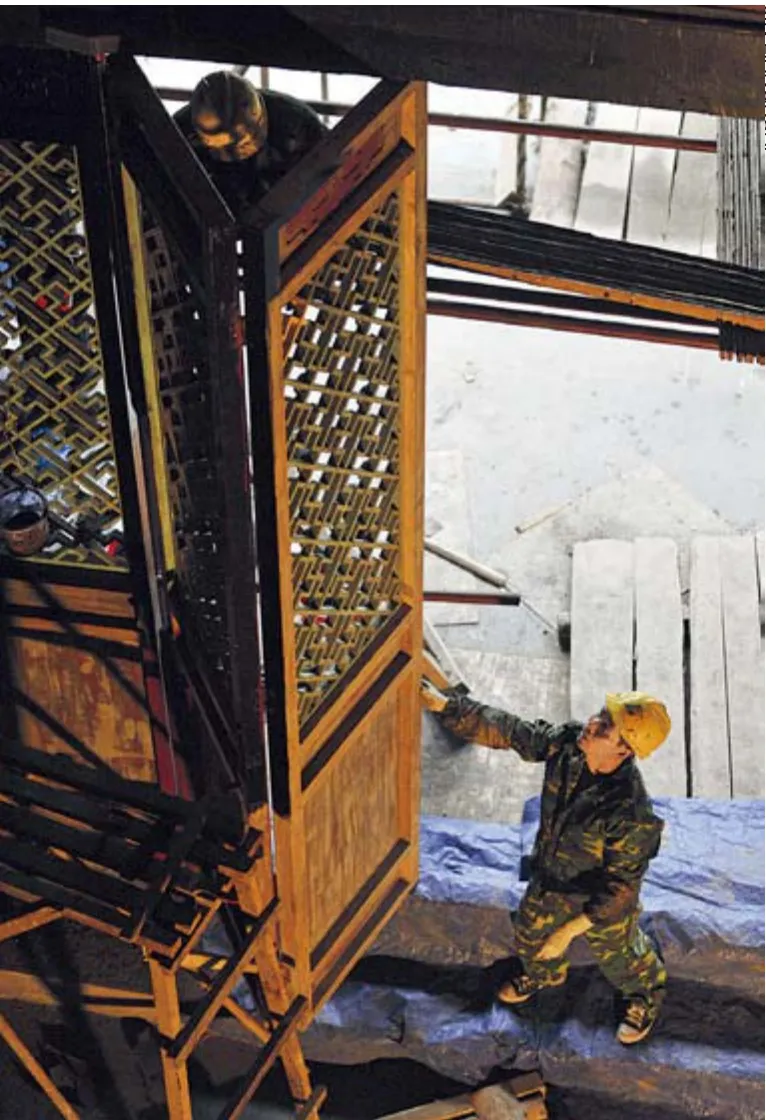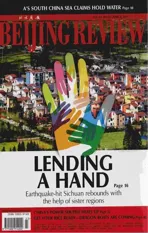Restoring Cultural Heritage Sites
2011-10-14ByWANGHAIRONG
By WANG HAIRONG
By DING YING
Restoring Cultural Heritage Sites
By WANG HAIRONG
Most of the post-quake cultural heritage rescue and protection projects in Sichuan have been completed
The State Administration of Cultural Heritage recently rewarded 132 individuals and organizations for their work in rescuing and protecting cultural relics damaged by the Wenchuan earthquake on May 12, 2008.
Two world cultural heritage sites, 145 key state-level cultural heritage sites and 285 provincial-level cultural heritage sites as well as more than 1,000 city or county-level cultural heritage sites in Sichuan, Gansu and Shaanxi provinces were damaged by the earthquake, said Shan Jixiang, Director of the State Administration of Cultural Heritage.
The earthquake also damaged 152 museums and cultural relic sites, Shan said. More than 4,100 cultural relics, including 420 precious cultural relics, were damaged.
Shan said 294 post-quake cultural heritage rescue and protection projects have been launched. As of May 2011, a total of 237 projects, or 80.6 percent of the total, had been completed. A total of 2.3 billion yuan ($353.8 million) had been spent, accounting for 87 percent of the total approved investment for these projects.
Now, many damaged cultural heritage sites such as the ancient building complex close to the Dujiangyan Irrigation System have been repaired and restored, while some cultural heritage museums and cultural relics stored therein are still under reconstruction, Shan said.
Swift action
Soon after the earthquake in 2008, the State Administration of Cultural Heritage and relevant departments in Sichuan, Gansu and Shaanxi provinces activated emergency plans to rescue and protect cultural items.
Key cultural relics closely related to people’s livelihoods were repaired first. Reconstruction of key cultural heritage sites such as the ancient building complex near the Dujiangyan Irrigation System and the watchtowers of the Qiang ethnic people started just one month after the earthquake.
Shan summarized a few lessons learned during the post-quake cultural heritage rescue and protection work.
During the rescue and protection work, cultural heritage administrative organizations should work closely with administrative organizations of meteorology, earthquake and land resources, so that the impact of geological and meteorological disasters on cultural heritages in the region can been evaluated, and vulnerable regions identifed.

JIN LIANGKUAI
Comprehensive disaster monitoring and evaluation systems for key cultural heritage sites should be established, and emergency plans regarding such natural disasters as earthquakes, landslides and foods should be made, according to Shan.
Post-quake cultural heritage rescue and protection work should be carried out in combination with environmental protection at cultural heritage sites. Structures at discord with the environment should be demolished.
The rescue and protection work should also be carried out in a way that promotes the economic and social development of the areas. The restoration of cultural heritages will boost tourism, which will increase people’s living standards and facilitate postquake reconstruction.
In the meantime, professionals specializing in cultural heritage rescue and protection should be trained in the process, which helps to pass on traditional architectural expertise and disseminate the idea of cultural heritage protection, especially in regions inhabited by such minority ethnic groups as the Qiang and Tibetan people, Shan added.
Shan said China’s work in rescuing and protecting cultural items in quake-stricken areas has been highly commended by the International Council on Monuments and Sites, an international NGO of professionals, dedicated to the conservation of the world’s historic monuments and sites.
Fulong Taoist Temple close to the Dujiangyan Irrigation System won the 2010 UNESCO Asia-Pacific Cultural Heritage Awards for Cultural Heritage Conservation. The temple, built in the Han Dynasty (206 B.C.—A.D. 220), was damaged in the earthquake. It is the first restoration project in the disaster-hit area and also the first completed.
Earthquake memorials
Not only damaged cultural items are being repaired, some earthquake ruins are preserved as memorials.
Some of the quake-devastated regions no longer suitable for human habitation have been converted into memorials, as long as the local social, economic and cultural conditions permit, Shan said.
Earthquake memorials will log this disastrous moment and preserve materials for future researches, he said.
The preservation and management of earthquake ruins have been carried out following the same standard of world cultural heritage sites, said Shan. Relevant exhibition and service facilities have been built, but their scales are strictly regulated.
Some relics have been exhibited in diversified ways, so that visitors can see, hear and feel the earthquake, he said.
By DING YING
